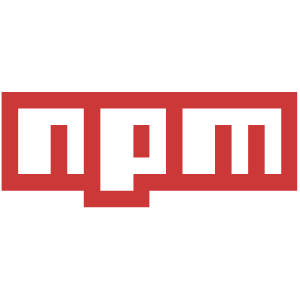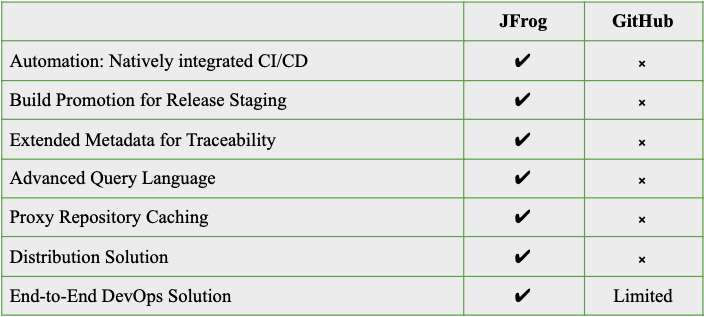What is Artifactory?
Artifactory is a branded term to refer to a repository manager that organizes all of your binary resources. These resources can include remote artifacts, proprietary libraries, and other third-party resources. A repository manager pulls all of these resources into a single location. The word “Artifactory” refers to the JFrog product, the JFrog Artifactory, but there are several other package managers out there such as Packagecloud.
Artifactory, and package managers at large, support build integration whether you are using one of the popular CI servers, building standalone without a CI server, or if you’re using a cloud-based CI server. Package managers can handle all dependencies and/or a build's artifacts as a single unit for bulk actions like exporting, moving, and copying.
What is JFrog?
JFrog Artifactory is a universal DevOps solution that manages and automates artifacts and binaries from start to finish during the application delivery process. It gives you the option to choose from 25+ software build packages, all major CI/CD systems, and other existing DevOps tools. Artifactory is a Kubernetes and Docker registry with full CLI and REST APIs that can be customized to your ecosystem. It supports containers, Helm Charts, and Docker.
Are there other kinds of repository managers?
There are other package managers out there, each with their own specific features and pricing:
1. Packagecloud (now Buildkite Package Registries)
 |
Packagecloud is a cloud-based package repository that allows its users to host npm, python, rubygem, apt, Java/Maven, and yum repositories without having to configure anything first. Being a cloud-based solution, it also allows one to distribute various software packages in a uniform, scalable, and dependable manner without investing in infrastructure. Regardless of the programming language or OS, you can keep all of the packages that you need to be deployed across your organization’s workstations in one repo. Then, without owning any of the infrastructure required, you may securely and efficiently distribute packages to your devices. With these powerful features, Packagecloud is a great alternative to JFrog.
Advantages of Packagecloud
-
Install the same packages with the same versions across all environments.
-
Ensure all of the packages used on a regular basis are scanned, secure, and hosted in a safe place.
-
Metadata in your Packagecloud resources helps users to understand what packages are installed and where they are, which gives great visibility for package management.
-
Packagecloud provides a unified and user-friendly interface for your metadata written in any language for any infrastructure.
2. Helix Core Version Control
 |
This tool is built on the Versioning engine that allows Perforce customers to manage their assets at the file level in real-time. Helix Core, previously Perforce Helix, is a large-scale development version control engine. It keeps track of a central database as well as a master repository of all conceivable file versions. GIT, GUI, Plugin, Command, and Web are the five categories of Helix Core clients ( depending on how they connect to the Code repository). A portion or all of Perforce’s material can be made accessible as GIT repositories. GIT and other clients can use this to operate with the same file content and history. Others will be able to see GIT commits as Perforce Changelists, and others will be able to see GIT commits as Perforce Changelists.
Advantages of Helix Core Version Control
- People can work from anywhere in the world, downloading only the files they need.
- People can put a lock on files to prevent binaries from being overwritten.
- For complete control, clients can establish granular permissions down to the file level.
- Even as the repositories grow in size, clients may expect consistent performance.
- Clients will have worldwide visibility, such as who has checked out which files and so on.
- Before commits, clients are granted the greatest tools for identifying discrepancies in the files they are working on in parallel.
- It automates and also simplifies branching best practices.
- It has a decent search feature that searches your whole repository for anything you're currently interested in.
3. Archiva
|
|
Archiva is an extensible repository management program that assists in the management of the enterprise-wide build artifact repository. It is another product from the Apache family of software solutions. An incoming request containing a virtual repository or a repository group URL would cause Archiva to search the repositories under that group for the requested artifact. Archiva, on the other hand, would only look for the artifact under the given group if it had the authorization to do so. As a response to the incoming request, the first resource found for the specified artifact would be returned.
Advantages of Archiva
- It saves a lot of time because there is no need to download any of the libraries from internal storage; instead, it downloads directly from your site's Archiva repository.
- Instead of multiple unmanageable repository locations on the Internet, the entire management procedure is centralized (i.e., from the Archiva repository).
4. Cloudsmith
Cloudsmith Package makes sure that your DevOps enterprise-grade repositories, such as Vagrant, Ruby, Python, Maven, Debian, and others, are leveled up. It allows you to concentrate on your product because Cloudsmith Package takes care of all of your concerns about the entire process and manages package management in the most efficient manner possible.
Advantages of Cloudsmith Package
-
If you're having problems keeping track of your dependencies, you can keep track of all of your universal dependencies and artifacts in a single repository.
-
Coudsmith makes sure there is no downtime and that throughput is increased.
-
Cloudsmith makes sure that you get reimbursed for the services you have received.
5. npm
 |
Teams and individuals are believed to have access to a new realm of JavaScript talent because of npm. It is among the most prominent software registries in the world, with more than 11 million packages or code-building pieces. When open source developers from all over the globe utilize it to borrow and exchange packages, it is beneficial to them.
All packages are organized so that you can keep track of all of the dependencies and their various versions. The registry, website, and command-line interface, or CLI, are the three components of npm. The npm website is where developers can find packages, create profiles, and manage other elements of the npm project. The npm registry is an extensive database that holds all the dependencies and the information, whereas the npm CLI is the most common way for developers to interact with npm.
Advantages on npm
-
You may quickly adapt packages to your apps using npm.
-
You can utilize standalone tools right away after downloading them.
-
You can share your code with everyone who uses npm.
-
Additionally, you can set restrictions on who can see and share this information.
-
You may create virtual teams and manage code versions.
-
It's simple to keep your applications up to date with modifications from underlying dependencies.
-
Find and cooperate with other developers who are working on challenges, problems, technologies, or products that are comparable to yours.
Github vs. Jfrog
GitHub has an impressive resume. They established the industry standard for source code collaboration tools, and GitHub's Version Control System, or VCS, may already be a key component of your development process. GitHub, which is now owned by Microsoft, is used by developers and, increasingly, operations, thanks to modern GitOps methods. With GitHub Actions for CI/CD and also GitHub Packages for local repositories, GitHub has built on this history. Another Microsoft acquisition, Dependabot, has been integrated to enable OSS security vulnerability supervision.
Artifactory, the first-in-class binary repository management that pioneers many modern DevOps methods, powers the JFrog DevOps Platform. The JFrog Platform is made up of scalable solutions that allow you to construct (JFrog Pipelines), distribute (JFrog Distribution), and secure (JFrog Xray) your software all in one place.
It’s all about your binaries when it comes to DevOps. Software development is all about code, and good codes come from giving smart people the tools to write them. Moreover, binaries are what software delivery is all about: assuring high-quality builds and also getting them to your clients’ devices quickly. Intelligent systems which know how to distribute and manage binaries produce high-quality binaries.
To help you with that:
JFrog vs. Packagecloud
Among others, JFrog appears to have strong capabilities in three major areas.
- hybrid and multi-cloud environments
- universal binary repository manager
- extensive metadata for all major package formats
These strengths then lead to further strong features including:
- A locality in all network topologies and all development methodologies
- high availability
- advanced CI server integration with build tools
- advanced search since there is Artifactory Query Language
- custom API-Driven automation
- Artifactory cloud with CDN distribution
Packagecloud, on the other hand, is a cloud-based software distribution solution for your workstations and contexts. Here, Node.js, Debian, RPM, Python, Java, and RubyGem repositories are all hosted for free. There are also integrations with Travis CI, CircleCI, Buildkite, Jenkins, Github Actions, Puppet, and Chef. With one Packagecloud repository, users can access:
- packages of any (or all) supported types can be found in the same Packagecloud repo; for instance, Debian, RPM, RubyGem, and Python packages can all coexist.
- packages for several Linux distributions; for instance, if you've got a Debian package that runs for two Ubuntu versions and one Debian version, you just need one Packagecloud repo.
- features to identify individual nodes and control access to a repository, issue read tokens.
Sign up for a 14 day trial with Packagecloud to effortlessly set up and update your machines! You will never have to stress yourself on your packages’ security, scaling, or consistency again.





